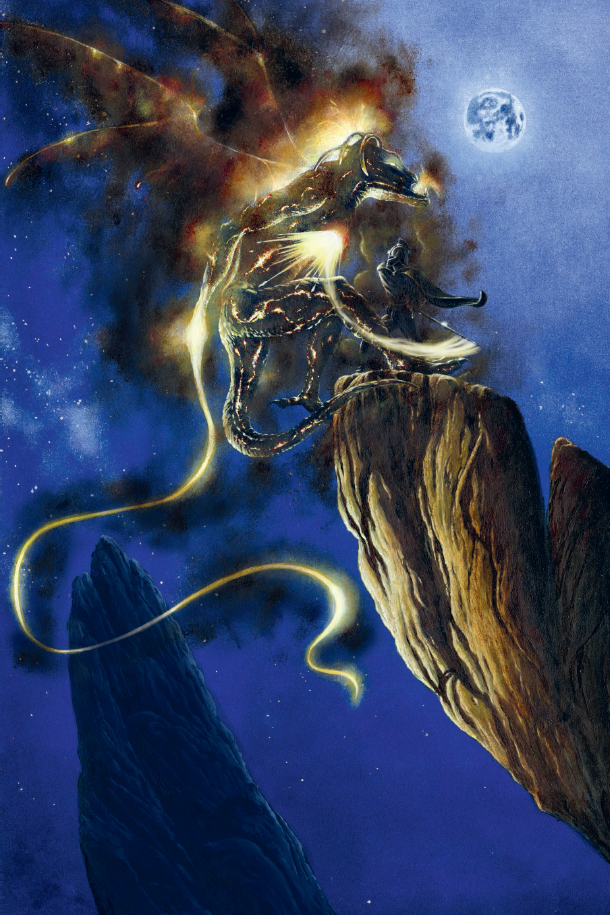GOTHMOG, “LORD OF BALROGS”

Among the most terrifying of Morgoth’s servants in the War of the Jewels are the Valaraukar, or “Cruel Demons”. These are mighty Maiar fire spirits that the Sindar Elves of Beleriand come to know as the Balrogs, “Demons of Might”. In Middle-earth, these spirits take the form of man-shaped giants shrouded in darkness with manes of fire, eyes that glow like burning coals, and nostrils that breathe flame. Balrogs wield many-thonged whips of fire in combination with mace, battle axe or flaming sword.
In some respects, the Balrogs are comparable to the demonic Furies of Greco-Roman mythology: although opposite in sex – the Balrogs are male – the female Furies are chthonic (Underworld) deities and avenging spirits who emerged from the pits of Hell. Variously described as having snakes for hair, coal-black bodies, bats’ wings and blood-red eyes, they attacked their victims with blazing torches and many-thonged brass-studded whips.
Nonetheless, whatever other mythical monsters might have inspired Tolkien, there can be little doubt that his primary inspiration was the fire giants of Muspelheim (Old Norse: Múspellsheimr), the Norse “region of fire”. The giant inhabitants of Muspelheim were those demonic fire spirits who, once released, were as unstoppable as the volcanic lava floes that were so familiar to the Norse settlers of Iceland.

Gothmog the Lord of Balrog’s battle with Fingon the High King of the Noldor

Halls of Angband
Muspelheim is also philologically linked to Tolkien’s Anglo-Saxon (Old English) studies. Since Joan Turville-Petre’s publication of Tolkien’s notes on the Old English Exodus, several scholars have linked this text to his invention of Balrogs. In these notes, Tolkien argued that the text’s Sigelwara land (“Land of the Ethiopians”) was a scribal error for Sigelhearwa land (“Land of Sun–Soot”) and thus an Old English reference to Muspelheim. The Sigelhearwan were therefore the fire giants, who were, in Tolkien’s own words, “rather the sons of Muspell … than of Ham [the biblical son of Noah, considered the forefather of the Ethiopians], the ancestors of the Sigelhearwan with red-hot eyes that emitted sparks, with faces as black as soot”.
The greatest of Tolkien’s Maiar fire spirits is Gothmog, Lord of Balrogs and High Captain of Angband. In early versions of The Silmarillion, Gothmog – meaning “Dread Oppressor” – was known as Kalimbo, and is variously described as a savage man, a giant, a monster and a troll. Perhaps, then, Tolkien imagined something akin to the Sumerian giant Humbaba in The Epic of Gilgamesh, “whose roar is a flood, whose mouth is fire and whose breath is death”. Curiously enough, in an early version of The Fall of Gondolin, Gothmog is “a son of Morgoth and the ogress Fluithuin”, but this changed once Tolkien had dispensed with the idea of Valar having children. The only other fire demon given a name by Tolkien was one Lungorthin, a Balrog lord in an early version of The Lay of the Children of Húrin.
Tolkien changed his conception of Balrogs over time. They became fewer, larger and more powerful. Being Maiar spirits, it may be assumed they could change shape at will and move invisibly and without form, but by the time of Morgoth’s appearance in Beleriand, they – like their master – appear to have lost their ability to shape-shift. Also, through multiple drafts, Balrogs dwindled in number from “a host” of hundreds or even thousands, down to – as a curious marginal note by Tolkien records – “at most seven”.
Whatever their number, by the end of the First Age, Tolkien informs us, the Balrog Host was entirely destroyed in the War of Wrath “save a few that fled and hid themselves in caverns inaccessible at the roots of the earth”.

Duel of Balrog and Glorfindel of Gondolin
